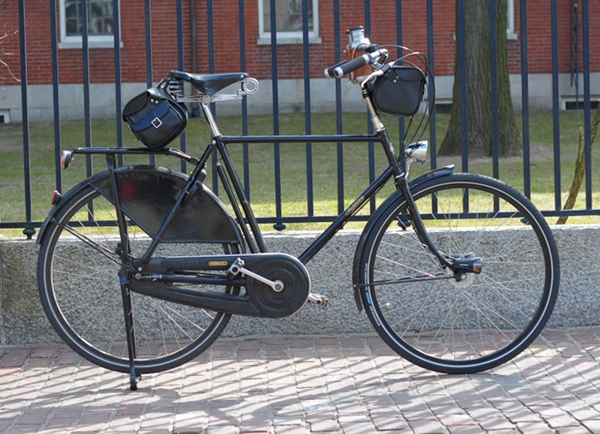
If you are a regular reader, you probably know that the Co-Habitant owns a
Pashley Roadster Sovereign. We bought a pair of
Pashleyswhen I first started this blog, and while I've since sold my Princess, he has kept his Roadster. He loves this bicycle. It is his main transportation bike, taking him to and from work every day for nearly two years now - in sunshine, rain and snow. This review is based on both his and my impressions of the bike.
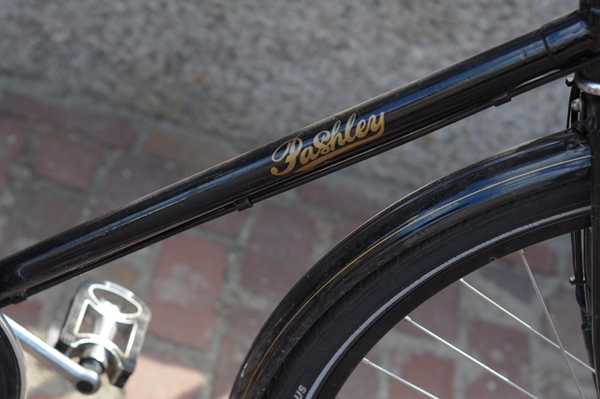 Pashley
Pashley bicycles have been made in Stratford-upon-Avon, England since 1926. The Roadster is a traditional lugged steel English roadster frame with relaxed geometry and 28" wheels. It is powdercoated black and fitted with a 5-speed
Sturmey Archer hub, dynamo lighting, and drum brakes. See here for the full specs and here for the complete set of images. This bicycle was purchased in May from
Harris Cyclery in West Newon, MA (not a sponsor at the time).
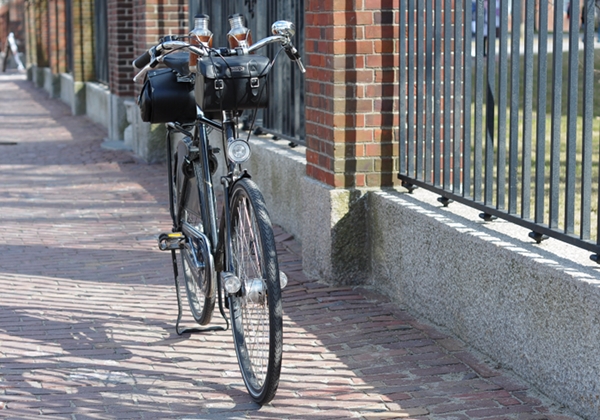
One interesting thing to note about this bike is the sizing. The Co-Habitant is 6' tall and his preferred frame size is normally 60-64cm, depending on geometry. However, his
Pashley's frame is only22.5" (57cm), and yet it is his size. That is because the
Pashley Roadster has an unusually high bottom bracket (330mm), which makes the standover considerably higher than it would be on a typical bike. For comparison, the bottom bracket height on his vintage
Raleigh DL-1 Roadster is 310mm, which in itself is considered high. This explains why the
Raleigh and
Pashley are both his size, despite the former being a 24" frame and the latter a 22.5" frame. When in doubt, go down a size with the
Pashley Roadster.
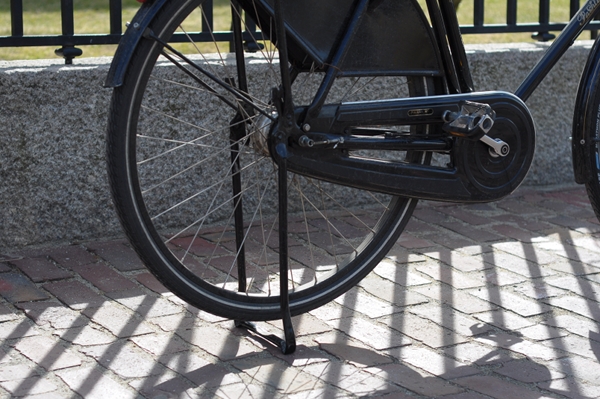
The
PashleyRoadster Sovereign is a bicycle fully equipped for commuting: generous fenders, full chaincase, vinyl dress guards, large rear rack, drop-down kickstand and an integrated wheel lock. The Co-Habitant finds the dressguards and chaincase convenient, because they enable him to wear pretty much anything he wants on the bike - including dressy clothing and overcoats. He does not like tucking his trousers into socks or wearing ankle straps when riding to work, so these features are important to him. The chaincase has kept his chain immaculately clean through two winters and does not stand in the way of rear wheel removal. For those who dislike the drop-down kickstand, the frame does come with a kickstand plate, so it's possible to install an alternative. Initially, we installed a
Pletcher double-legged kickstand and used it instead of the drop-down, until it broke, so now it's back to the original.
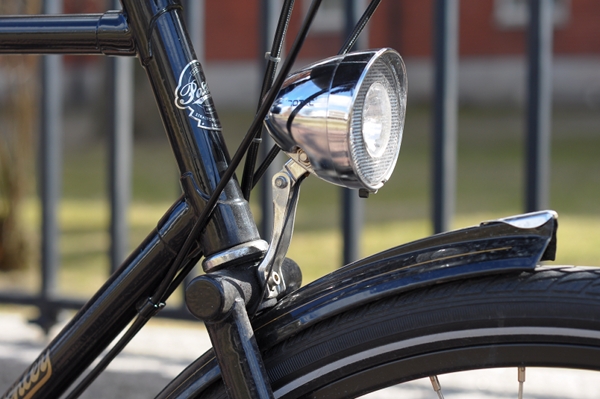
Though the headlight on the Roadster is dynamo-powered, the tail light is battery-operated. The 2.4W dynamo hub makes it difficult to modify this lighting set-up, and we are really not sure why
Pashley chose to do this instead of using a 3W hub and bulb. We are considering eventually replacing the lighting on his bike with a front and rear LED system with standlights. Trouble is, there aren't any classic LED headlights in a style that would suit the
Pashley.

Supplementary
Cateye battery lights attached for situations when visibility is especially poor. The bolts on the
Pashley's front axel make it easy to mount these.

The rear rack is spacious, but made of such thick tubing that most pannier mounting systems will not fit it. The
Ortlieb QL2 and the
R&K Klick-fix systems
sort of fit, but just barely.

Tires are
Schwalbe Marathon Plus. They are not my favourite tires, but the puncture protection is unbeatable.

The saddle is the super-sprung Brooks B33 - especially suitable for the larger gentlemen on upright bikes.

And of course, the shiny "ding dong" bell. That's us, reflected in it.

Though we are both lovers of customisations, there wasn't much that the Co-Habitant modified on this bicycle. All the components have remained stock thus far. As far as positioning, he lowered the handlebars to make them level with the saddle and angled them down a bit, for a more aggressive position. He also shoved the saddle forward by means of reversing the seat clamp. He added a
Brooks Glenbrook saddlebag and Millbrook handlebar bag, which are permanently affixed to the bike. The saddlebag contains his lock, bungee cords and saddle cover in the side pockets, with the main compartment kept empty for quick grocery trips and other errands.
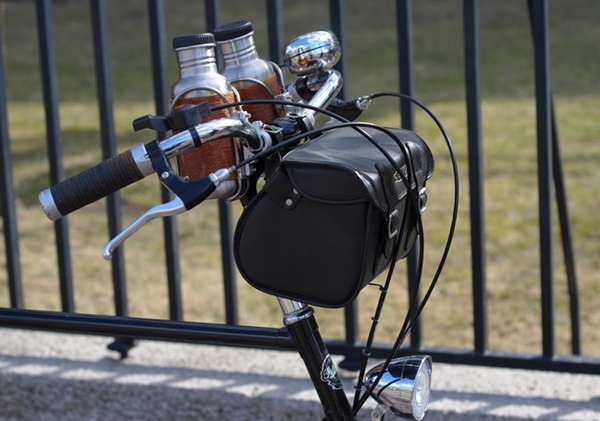
The handlebar bag contains his rain gear, gloves, bad-weather cycling glasses, flashlight, and epic toolkit. The toolkit he carries only on longer trips.

The original plastic handlebar grips were replaced with the
Brooks leather washer grips. Front and rear drum brakes are hand-operated, and he has them routedright-front.And just in case you haven't noticed, the handlebar set-up includes a cycling computer and twined water bottles in their DIY handlebar mounts. The computer is fairly unobtrusive, blending in with the black part of the riser stem.

And a close-up of he bottle cage mounts. The set-up with the twin bottles sticking out like miniature cannons over the handlebars is over-the-top eccentric for me - but over time I've grown used to seeing them on his bike and even find them endearing. He has also carried paper cups full of coffee in those bottle cages - successfully.
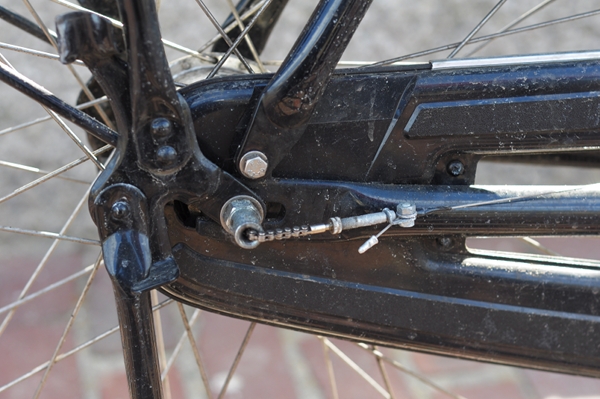
We considered washing the bicycle before taking pictures for the review, but ultimately decided against it. These pictures realistically portray what the bike looks like after a winter of commuting - and a harsh winter at that. The only time this frame has ever been wiped down was after the previous winter. With everything either fully enclosed or stainless, the
Pashley Roadster is as low-maintenance as they get. The powdercoating has held up excellently, with just a few scuffs here and there.Over the time he's owned this bicycle, the Co-Habitant has broken two spokes on the rear wheel (one per year) and had them replaced. The wheels also had to be re-trued a couple of times, no doubt due to the horrible pothole-ridden roads on which he commutes. Otherwise, significant adjustments have not been necessary.
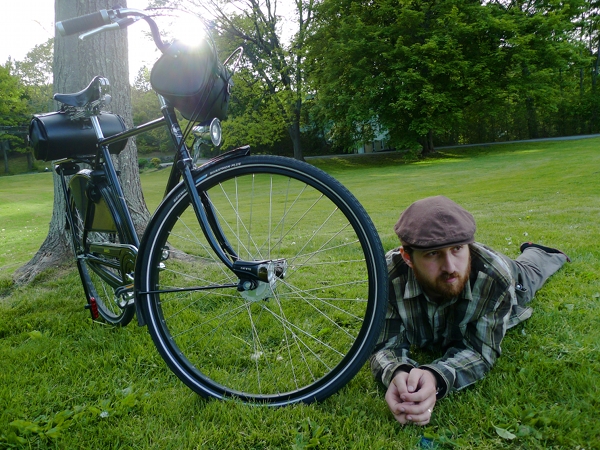
As far as ride quality and subjective feedback go, there is a distinct feeling of the bicycle being stable, reliable and enormous.
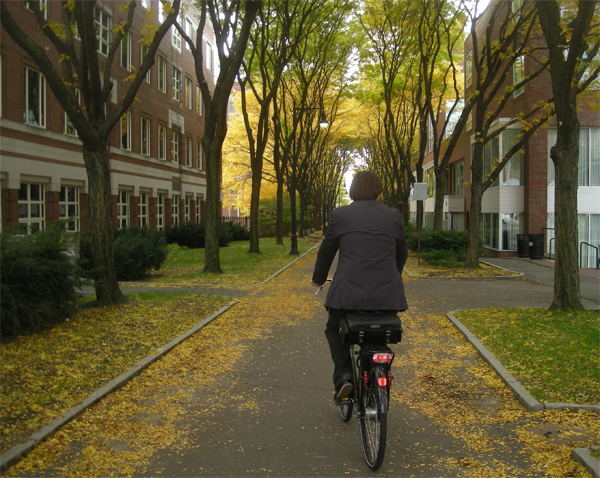
It can comfortably travel at high speeds, with the cyclist feeling relaxed, perched high above city traffic. And this isn't merely an illusion - with the high bottom bracket and the upright sitting position, the height at which the rider is placed really is out of the ordinary.

The bicycle handles well on the road and off, in dry and wet conditions.In the winter, it has proven to be a trusty companion.
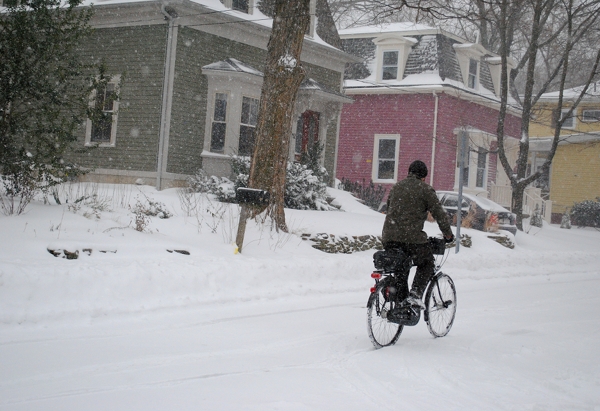
Even during blizzards, the Co-Habitant continued to commute on this bicycle, and felt comfortable doing it.

When describing the
Pashley Roadster's ride quality, it is worth noting that it is
not the male equivalent of the Princess model: The geometry and handling of the two bikes are different. Performace-wise, the Roadster accelerates faster and climbs hills easier than the Princess, which can be problematic for those who buy the two bikes as a "his and hers" pair. Though this discrepancy between the men's and women's models is unfortunate, the Roadster's performance in itself is terrific.

As for my own impressions of the Co-Habitant's
Pashley, I've come to see the bike as his permanent companion or even an extension of his personality. He loves the bike, never complains about it, and uses it daily for transportation, which is fantastic. But sometimes I do wonder whether the bike is overbuilt for his purposes: To me it seems excessively heavy, and I don't get the point of having that monstrous rear rack if it is seldom used for anything other than saddlebag support. Also, it takes great effort to convince him to leave the bike locked up in the city, which is frustrating. At work he has secure locking facilities, but when we go out he worries about the bike too much - which in my view somewhat undermines its usefulness. However, the most important thing is that
he enjoys the bike and rides it, which I feel has been accomplished here pretty well.

Though the
Pashley Roadster Sovereign is not inexpensive by any means, it is a good value once you consider what is included and add it all up: a traditional lugged frame made in England and a fully integrated "commuting package" consisting of fenders, drum brakes, full chaincase, dressguards, puncture-proof tires, lighting, and a high quality sprung leather saddle. After close to two years of daily use, including two New England winters, the bicycle looks hardly worse for wear - a testament to its durability. As with everything, your impressions may differ, but the Co-Habitant is a happy owner. He is not looking for another transportation bicycle for the foreseeable future.
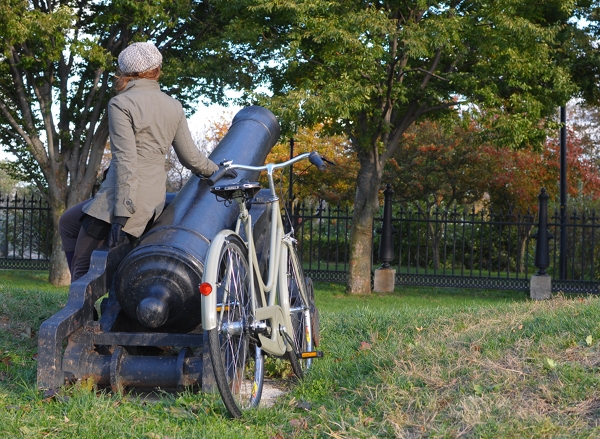 For myself and a number of my acquaintances, the desire to get a bicycle corresponded with experiencing what I can only describe as an early midlife crisis. Early, because it hit us some time in our late 20s. And crisis, because it was marked by a devastating discrepancy between what we were achieving in our lives at the time (impressive things, by society's standards) and the absolute lack of personal fulfilment derived from those achievements. Somehow, we were living in a way that did not make us happy, spending money on things we did not enjoy, and advancing along career paths we no longer believed in - yet saw no way of escaping after having dedicated huge portions of our no-longer-that-young lives to the education that led to those careers.
For myself and a number of my acquaintances, the desire to get a bicycle corresponded with experiencing what I can only describe as an early midlife crisis. Early, because it hit us some time in our late 20s. And crisis, because it was marked by a devastating discrepancy between what we were achieving in our lives at the time (impressive things, by society's standards) and the absolute lack of personal fulfilment derived from those achievements. Somehow, we were living in a way that did not make us happy, spending money on things we did not enjoy, and advancing along career paths we no longer believed in - yet saw no way of escaping after having dedicated huge portions of our no-longer-that-young lives to the education that led to those careers. This is Stonegate, a busy shopping lane.
This is Stonegate, a busy shopping lane.



 I do not think I have been to a church with box pews. These are indeed a rare find. It is very special to see them being preserved for the sake of history and posterity. I made sure to give a donation before leaving the small church.
I do not think I have been to a church with box pews. These are indeed a rare find. It is very special to see them being preserved for the sake of history and posterity. I made sure to give a donation before leaving the small church.




















 Fotos above were taken on Goodramgate, Micklegate, Stonegate, Colliergate and Barley Hall.
Fotos above were taken on Goodramgate, Micklegate, Stonegate, Colliergate and Barley Hall. If you are a regular reader, you probably know that the Co-Habitant owns a Pashley Roadster Sovereign. We bought a pair of Pashleyswhen I first started this blog, and while I've since sold my Princess, he has kept his Roadster. He loves this bicycle. It is his main transportation bike, taking him to and from work every day for nearly two years now - in sunshine, rain and snow. This review is based on both his and my impressions of the bike.
If you are a regular reader, you probably know that the Co-Habitant owns a Pashley Roadster Sovereign. We bought a pair of Pashleyswhen I first started this blog, and while I've since sold my Princess, he has kept his Roadster. He loves this bicycle. It is his main transportation bike, taking him to and from work every day for nearly two years now - in sunshine, rain and snow. This review is based on both his and my impressions of the bike. Pashley bicycles have been made in Stratford-upon-Avon, England since 1926. The Roadster is a traditional lugged steel English roadster frame with relaxed geometry and 28" wheels. It is powdercoated black and fitted with a 5-speed Sturmey Archer hub, dynamo lighting, and drum brakes. See here for the full specs and here for the complete set of images. This bicycle was purchased in May from Harris Cyclery in West Newon, MA (not a sponsor at the time).
Pashley bicycles have been made in Stratford-upon-Avon, England since 1926. The Roadster is a traditional lugged steel English roadster frame with relaxed geometry and 28" wheels. It is powdercoated black and fitted with a 5-speed Sturmey Archer hub, dynamo lighting, and drum brakes. See here for the full specs and here for the complete set of images. This bicycle was purchased in May from Harris Cyclery in West Newon, MA (not a sponsor at the time). One interesting thing to note about this bike is the sizing. The Co-Habitant is 6' tall and his preferred frame size is normally 60-64cm, depending on geometry. However, his Pashley's frame is only22.5" (57cm), and yet it is his size. That is because the Pashley Roadster has an unusually high bottom bracket (330mm), which makes the standover considerably higher than it would be on a typical bike. For comparison, the bottom bracket height on his vintage Raleigh DL-1 Roadster is 310mm, which in itself is considered high. This explains why theRaleigh and Pashley are both his size, despite the former being a 24" frame and the latter a 22.5" frame. When in doubt, go down a size with the Pashley Roadster.
One interesting thing to note about this bike is the sizing. The Co-Habitant is 6' tall and his preferred frame size is normally 60-64cm, depending on geometry. However, his Pashley's frame is only22.5" (57cm), and yet it is his size. That is because the Pashley Roadster has an unusually high bottom bracket (330mm), which makes the standover considerably higher than it would be on a typical bike. For comparison, the bottom bracket height on his vintage Raleigh DL-1 Roadster is 310mm, which in itself is considered high. This explains why theRaleigh and Pashley are both his size, despite the former being a 24" frame and the latter a 22.5" frame. When in doubt, go down a size with the Pashley Roadster. The PashleyRoadster Sovereign is a bicycle fully equipped for commuting: generous fenders, full chaincase, vinyl dress guards, large rear rack, drop-down kickstand and an integrated wheel lock. The Co-Habitant finds the dressguards and chaincase convenient, because they enable him to wear pretty much anything he wants on the bike - including dressy clothing and overcoats. He does not like tucking his trousers into socks or wearing ankle straps when riding to work, so these features are important to him. The chaincase has kept his chain immaculately clean through two winters and does not stand in the way of rear wheel removal. For those who dislike the drop-down kickstand, the frame does come with a kickstand plate, so it's possible to install an alternative. Initially, we installed a Pletcher double-legged kickstand and used it instead of the drop-down, until it broke, so now it's back to the original.
The PashleyRoadster Sovereign is a bicycle fully equipped for commuting: generous fenders, full chaincase, vinyl dress guards, large rear rack, drop-down kickstand and an integrated wheel lock. The Co-Habitant finds the dressguards and chaincase convenient, because they enable him to wear pretty much anything he wants on the bike - including dressy clothing and overcoats. He does not like tucking his trousers into socks or wearing ankle straps when riding to work, so these features are important to him. The chaincase has kept his chain immaculately clean through two winters and does not stand in the way of rear wheel removal. For those who dislike the drop-down kickstand, the frame does come with a kickstand plate, so it's possible to install an alternative. Initially, we installed a Pletcher double-legged kickstand and used it instead of the drop-down, until it broke, so now it's back to the original. Though the headlight on the Roadster is dynamo-powered, the tail light is battery-operated. The 2.4W dynamo hub makes it difficult to modify this lighting set-up, and we are really not sure why Pashley chose to do this instead of using a 3W hub and bulb. We are considering eventually replacing the lighting on his bike with a front and rear LED system with standlights. Trouble is, there aren't any classic LED headlights in a style that would suit the Pashley.
Though the headlight on the Roadster is dynamo-powered, the tail light is battery-operated. The 2.4W dynamo hub makes it difficult to modify this lighting set-up, and we are really not sure why Pashley chose to do this instead of using a 3W hub and bulb. We are considering eventually replacing the lighting on his bike with a front and rear LED system with standlights. Trouble is, there aren't any classic LED headlights in a style that would suit the Pashley. SupplementaryCateye battery lights attached for situations when visibility is especially poor. The bolts on the Pashley's front axel make it easy to mount these.
SupplementaryCateye battery lights attached for situations when visibility is especially poor. The bolts on the Pashley's front axel make it easy to mount these. The rear rack is spacious, but made of such thick tubing that most pannier mounting systems will not fit it. The Ortlieb QL2 and the R&K Klick-fix systems sort of fit, but just barely.
The rear rack is spacious, but made of such thick tubing that most pannier mounting systems will not fit it. The Ortlieb QL2 and the R&K Klick-fix systems sort of fit, but just barely.  Tires are Schwalbe Marathon Plus. They are not my favourite tires, but the puncture protection is unbeatable.
Tires are Schwalbe Marathon Plus. They are not my favourite tires, but the puncture protection is unbeatable. The saddle is the super-sprung Brooks B33 - especially suitable for the larger gentlemen on upright bikes.
The saddle is the super-sprung Brooks B33 - especially suitable for the larger gentlemen on upright bikes. And of course, the shiny "ding dong" bell. That's us, reflected in it.
And of course, the shiny "ding dong" bell. That's us, reflected in it. Though we are both lovers of customisations, there wasn't much that the Co-Habitant modified on this bicycle. All the components have remained stock thus far. As far as positioning, he lowered the handlebars to make them level with the saddle and angled them down a bit, for a more aggressive position. He also shoved the saddle forward by means of reversing the seat clamp. He added a Brooks Glenbrook saddlebag and Millbrook handlebar bag, which are permanently affixed to the bike. The saddlebag contains his lock, bungee cords and saddle cover in the side pockets, with the main compartment kept empty for quick grocery trips and other errands.
Though we are both lovers of customisations, there wasn't much that the Co-Habitant modified on this bicycle. All the components have remained stock thus far. As far as positioning, he lowered the handlebars to make them level with the saddle and angled them down a bit, for a more aggressive position. He also shoved the saddle forward by means of reversing the seat clamp. He added a Brooks Glenbrook saddlebag and Millbrook handlebar bag, which are permanently affixed to the bike. The saddlebag contains his lock, bungee cords and saddle cover in the side pockets, with the main compartment kept empty for quick grocery trips and other errands. The handlebar bag contains his rain gear, gloves, bad-weather cycling glasses, flashlight, and epic toolkit. The toolkit he carries only on longer trips.
The handlebar bag contains his rain gear, gloves, bad-weather cycling glasses, flashlight, and epic toolkit. The toolkit he carries only on longer trips. The original plastic handlebar grips were replaced with the Brooks leather washer grips. Front and rear drum brakes are hand-operated, and he has them routedright-front.And just in case you haven't noticed, the handlebar set-up includes a cycling computer and twined water bottles in their DIY handlebar mounts. The computer is fairly unobtrusive, blending in with the black part of the riser stem.
The original plastic handlebar grips were replaced with the Brooks leather washer grips. Front and rear drum brakes are hand-operated, and he has them routedright-front.And just in case you haven't noticed, the handlebar set-up includes a cycling computer and twined water bottles in their DIY handlebar mounts. The computer is fairly unobtrusive, blending in with the black part of the riser stem. And a close-up of he bottle cage mounts. The set-up with the twin bottles sticking out like miniature cannons over the handlebars is over-the-top eccentric for me - but over time I've grown used to seeing them on his bike and even find them endearing. He has also carried paper cups full of coffee in those bottle cages - successfully.
And a close-up of he bottle cage mounts. The set-up with the twin bottles sticking out like miniature cannons over the handlebars is over-the-top eccentric for me - but over time I've grown used to seeing them on his bike and even find them endearing. He has also carried paper cups full of coffee in those bottle cages - successfully. We considered washing the bicycle before taking pictures for the review, but ultimately decided against it. These pictures realistically portray what the bike looks like after a winter of commuting - and a harsh winter at that. The only time this frame has ever been wiped down was after the previous winter. With everything either fully enclosed or stainless, the Pashley Roadster is as low-maintenance as they get. The powdercoating has held up excellently, with just a few scuffs here and there.Over the time he's owned this bicycle, the Co-Habitant has broken two spokes on the rear wheel (one per year) and had them replaced. The wheels also had to be re-trued a couple of times, no doubt due to the horrible pothole-ridden roads on which he commutes. Otherwise, significant adjustments have not been necessary.
We considered washing the bicycle before taking pictures for the review, but ultimately decided against it. These pictures realistically portray what the bike looks like after a winter of commuting - and a harsh winter at that. The only time this frame has ever been wiped down was after the previous winter. With everything either fully enclosed or stainless, the Pashley Roadster is as low-maintenance as they get. The powdercoating has held up excellently, with just a few scuffs here and there.Over the time he's owned this bicycle, the Co-Habitant has broken two spokes on the rear wheel (one per year) and had them replaced. The wheels also had to be re-trued a couple of times, no doubt due to the horrible pothole-ridden roads on which he commutes. Otherwise, significant adjustments have not been necessary. As far as ride quality and subjective feedback go, there is a distinct feeling of the bicycle being stable, reliable and enormous.
As far as ride quality and subjective feedback go, there is a distinct feeling of the bicycle being stable, reliable and enormous. It can comfortably travel at high speeds, with the cyclist feeling relaxed, perched high above city traffic. And this isn't merely an illusion - with the high bottom bracket and the upright sitting position, the height at which the rider is placed really is out of the ordinary.
It can comfortably travel at high speeds, with the cyclist feeling relaxed, perched high above city traffic. And this isn't merely an illusion - with the high bottom bracket and the upright sitting position, the height at which the rider is placed really is out of the ordinary. The bicycle handles well on the road and off, in dry and wet conditions.In the winter, it has proven to be a trusty companion.
The bicycle handles well on the road and off, in dry and wet conditions.In the winter, it has proven to be a trusty companion. Even during blizzards, the Co-Habitant continued to commute on this bicycle, and felt comfortable doing it.
Even during blizzards, the Co-Habitant continued to commute on this bicycle, and felt comfortable doing it. When describing the Pashley Roadster's ride quality, it is worth noting that it is not the male equivalent of the Princess model: The geometry and handling of the two bikes are different. Performace-wise, the Roadster accelerates faster and climbs hills easier than the Princess, which can be problematic for those who buy the two bikes as a "his and hers" pair. Though this discrepancy between the men's and women's models is unfortunate, the Roadster's performance in itself is terrific.
When describing the Pashley Roadster's ride quality, it is worth noting that it is not the male equivalent of the Princess model: The geometry and handling of the two bikes are different. Performace-wise, the Roadster accelerates faster and climbs hills easier than the Princess, which can be problematic for those who buy the two bikes as a "his and hers" pair. Though this discrepancy between the men's and women's models is unfortunate, the Roadster's performance in itself is terrific. As for my own impressions of the Co-Habitant's Pashley, I've come to see the bike as his permanent companion or even an extension of his personality. He loves the bike, never complains about it, and uses it daily for transportation, which is fantastic. But sometimes I do wonder whether the bike is overbuilt for his purposes: To me it seems excessively heavy, and I don't get the point of having that monstrous rear rack if it is seldom used for anything other than saddlebag support. Also, it takes great effort to convince him to leave the bike locked up in the city, which is frustrating. At work he has secure locking facilities, but when we go out he worries about the bike too much - which in my view somewhat undermines its usefulness. However, the most important thing is that he enjoys the bike and rides it, which I feel has been accomplished here pretty well.
As for my own impressions of the Co-Habitant's Pashley, I've come to see the bike as his permanent companion or even an extension of his personality. He loves the bike, never complains about it, and uses it daily for transportation, which is fantastic. But sometimes I do wonder whether the bike is overbuilt for his purposes: To me it seems excessively heavy, and I don't get the point of having that monstrous rear rack if it is seldom used for anything other than saddlebag support. Also, it takes great effort to convince him to leave the bike locked up in the city, which is frustrating. At work he has secure locking facilities, but when we go out he worries about the bike too much - which in my view somewhat undermines its usefulness. However, the most important thing is that he enjoys the bike and rides it, which I feel has been accomplished here pretty well. Though the Pashley Roadster Sovereign is not inexpensive by any means, it is a good value once you consider what is included and add it all up: a traditional lugged frame made in England and a fully integrated "commuting package" consisting of fenders, drum brakes, full chaincase, dressguards, puncture-proof tires, lighting, and a high quality sprung leather saddle. After close to two years of daily use, including two New England winters, the bicycle looks hardly worse for wear - a testament to its durability. As with everything, your impressions may differ, but the Co-Habitant is a happy owner. He is not looking for another transportation bicycle for the foreseeable future.
Though the Pashley Roadster Sovereign is not inexpensive by any means, it is a good value once you consider what is included and add it all up: a traditional lugged frame made in England and a fully integrated "commuting package" consisting of fenders, drum brakes, full chaincase, dressguards, puncture-proof tires, lighting, and a high quality sprung leather saddle. After close to two years of daily use, including two New England winters, the bicycle looks hardly worse for wear - a testament to its durability. As with everything, your impressions may differ, but the Co-Habitant is a happy owner. He is not looking for another transportation bicycle for the foreseeable future.